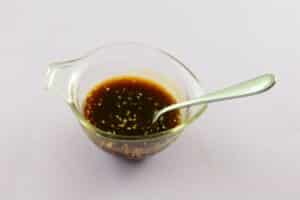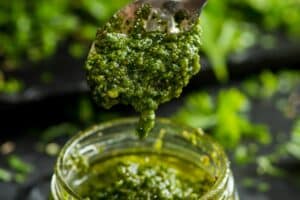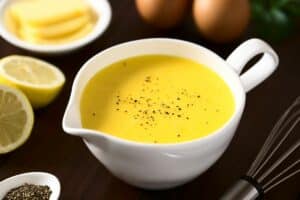Have you ever tasted Bearnaise sauce?
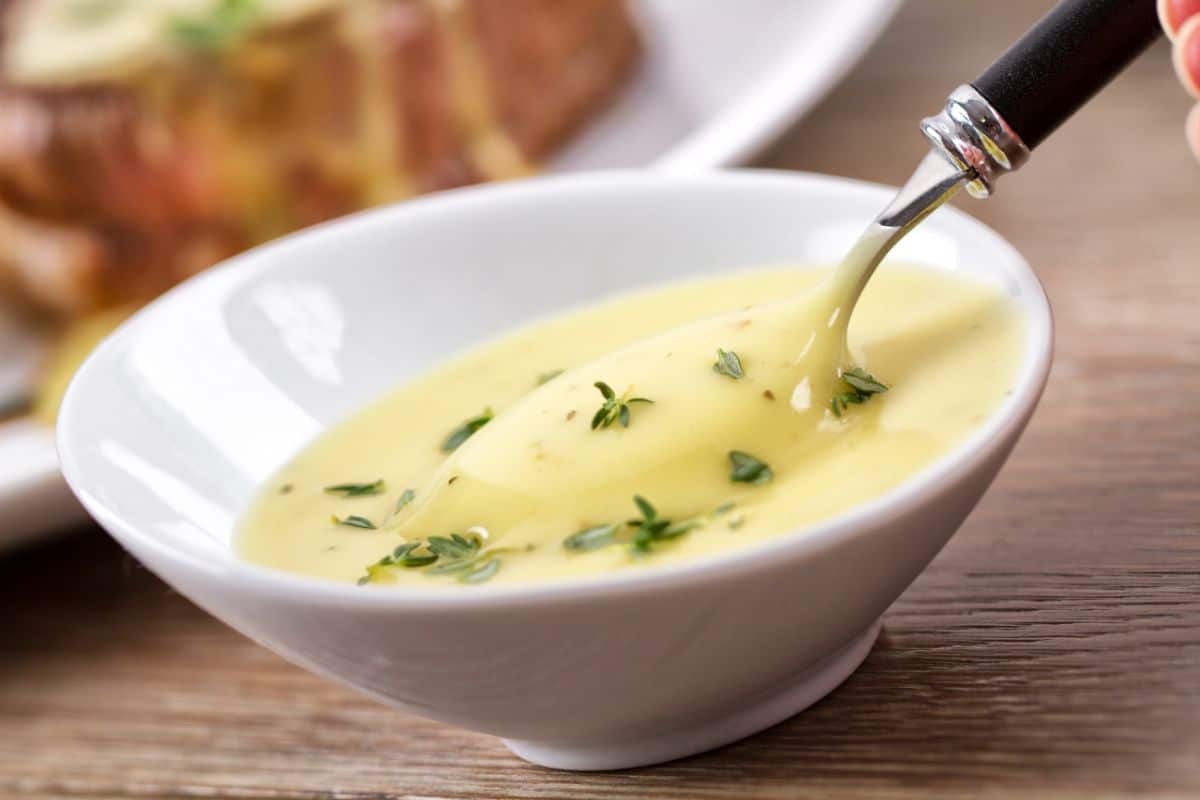
Bearnaise sauce is a staple of French cuisine, and it’s no wonder why. The sauce boasts a rich, creamy texture and a complex flavor profile that complements a variety of dishes.
Throughout the years, the recipe has evolved, and now there are countless variations on this classic sauce.
If you’re unfamiliar with this sauce, then you’re in for a treat as, in this article, we will discuss all things Bearnaise and explore its taste, history, ingredients, and pairings.
So, keep reading to learn more!
What Is Bearnaise?
Bearnaise sauce is a classic French sauce that originated in the 19th century. It is a derivative of Hollandaise sauce, another famous sauce from French cuisine.
The name “Bearnaise” comes from the province of Bearn in southwest France, where the sauce is said to have originated.
It is traditionally served with beef dishes, such as steak or filet mignon, but it is also a popular accompaniment to fish, chicken, and vegetables.
Moreover, bearnaise sauce has a reputation for being challenging to make, as it requires precise timing and temperature control to prevent the egg yolks from curdling.
However, with practice and patience, anyone can master the art of making Bearnaise sauce at home.
History Of Bearnaise Sauce
Bearnaise sauce was first created by the chef Auguste Escoffier in the late 19th century.
Escoffier is considered one of the most influential chefs in French cuisine, and the bearnaise recipe was inspired by Hollandaise sauce, which was already a staple in French cuisine.
Over the years, the recipe for Bearnaise sauce has been refined and altered by various chefs. Some variations include using different herbs and spices, such as chervil, parsley, or thyme.
However, others have experimented with adding mustard or white wine to the sauce to give it an extra tang!
Today, Bearnaise sauce is a popular accompaniment to many dishes, both in French cuisine and beyond; it can be found on menus in fine dining restaurants and is also a popular addition to home-cooked meals.
And in recent years, chefs have experimented with new ways to incorporate Bearnaise sauce into their dishes, such as using it as a dip for fries or as a topping for burgers!
What Are The Ingredients Of Bearnaise Sauce?
Bearnaise sauce is made from a few simple ingredients that come together to create a complex flavor profile. Here are the basic ingredients you’ll need to make Bearnaise sauce:
- Clarified butter: This is melted butter from which the milk solids and water have been removed. It is important to use clarified butter to prevent the sauce from separating.
- Egg yolks: These provide the base for the sauce and help to emulsify the butter.
- Vinegar or white wine reduction: This adds acidity to the sauce and helps to balance out the richness of the butter.
- Shallots: These are finely chopped and added to the vinegar reduction for flavor.
- Tarragon: This is the key herb in Bearnaise sauce and gives it its distinctive flavor. Chervil, another herb, is also commonly used.
- Salt and pepper: These are added to taste.
Variations And Substitutions
While the above ingredients are the traditional components of Bearnaise sauce, there are variations and substitutions that can be made to suit individual tastes or dietary restrictions.
For example, lemon juice can be used in place of vinegar, and some recipes call for the addition of Dijon mustard.
Vegans can substitute the egg yolks with aquafaba, a liquid from canned chickpeas that can be whipped like egg whites.
The Flavor Profile Of Bearnaise Sauce
Where do we start with the flavor profile of Bearnaise sauce?
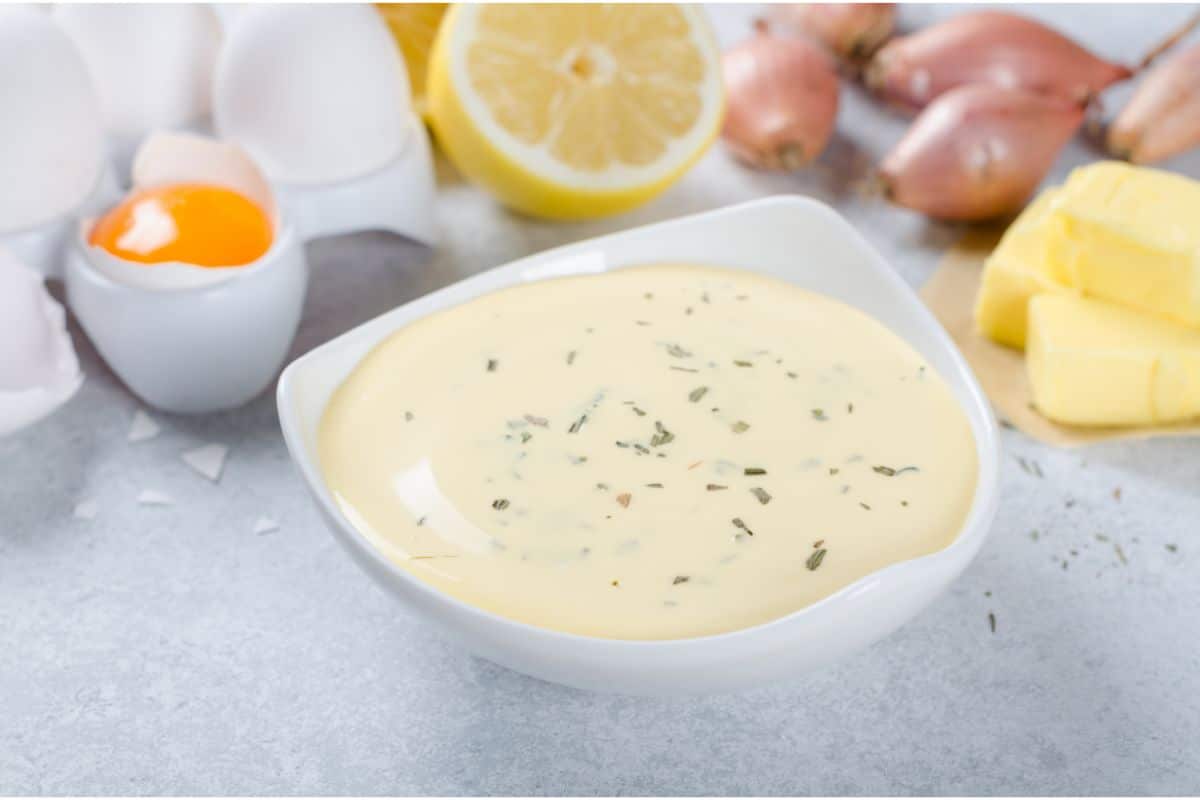
Let’s just say that it’s a party in your mouth as this velvety smooth sauce is a symphony of flavors that will leave your taste buds singing.
First off, the buttery richness of the sauce is just divine. It’s like liquid gold, coating your tongue in a luxurious, creamy texture.
But it’s not just any butter; as we have already mentioned, it’s clarified butter, which means all the impurities have been removed, leaving behind pure, buttery goodness.
Then there’s the tangy acidity from the vinegar, which cuts through the richness of the butter and adds a brightness to the sauce.
But again, it’s not just any vinegar; it’s been reduced down to a syrupy consistency, intensifying its flavor and giving the sauce a deeper complexity.
And let’s not forget about the herbs.
Tarragon is the star of the show here, giving the sauce its distinctive anise-like flavor.
It’s like a little burst of freshness in each bite. And chervil adds a subtle sweetness that balances out the tanginess of the vinegar.
All these flavors work together in perfect harmony to create a sauce that is just, well, delicious.
It’s the perfect accompaniment to a juicy steak or roasted vegetables, but honestly, you could put this stuff on cardboard and it would taste amazing (okay, maybe not cardboard, but you get the idea).
Pairing Bearnaise Sauce With Foods
If you’re not pairing Bearnaise sauce with your meals, you’re missing out on a whole world of deliciousness!
This sauce is so versatile that it can pretty much go with anything, but here are some of our favorite pairings:
Steak
Let’s start with the obvious one:steak and Bearnaise sauce are a match made in food heaven.
The richness of the sauce complements the beefiness of the steak perfectly, and the tangy acidity cuts through the fattiness of the meat.
It’s like a culinary love affair.
Salmon
While Bearnaise sauce is typically associated with red meat, it’s actually a fantastic pairing with fish too, especially salmon.
The butteriness of the sauce pairs well with the rich, fatty flavor of the fish, and the herbs add a pop of freshness.
Eggs
Eggs Benedict, anyone? Bearnaise sauce is a classic component of this breakfast dish, but it’s also a great pairing with scrambled or poached eggs.
It’s like a fancy upgrade to your standard brunch fare.
Roasted Vegetables
Don’t forget about the veggies! Bearnaise sauce is a great way to elevate roasted vegetables, such as asparagus or Brussels sprouts.
The tanginess of the sauce adds a nice contrast to the sweetness of the veggies.
Burgers
Who says Bearnaise sauce is only for fancy meals? It’s also a fantastic topping for burgers.
Trust us, once you’ve had a juicy burger with a dollop of Bearnaise sauce, you’ll never go back to ketchup.
Making Bearnaise Sauce At Home
Are you ready to take your culinary skills to the next level? Making Bearnaise sauce at home may seem intimidating, but with this step-by-step guide, you’ll be a pro in no time!
Step-by-Step Guide
- Gather your ingredients: You’ll need egg yolks, butter, white wine vinegar, shallots, tarragon, chervil, and salt.
- Melt the butter: Clarify the butter by melting it in a saucepan over low heat, then remove from heat and let it sit for a few minutes to allow the milk solids to settle at the bottom.
- Make the reduction: In a separate saucepan, combine the vinegar, shallots, and herbs, and simmer until the liquid is reduced by half.
- Strain the reduction: Strain the reduction through a fine mesh strainer, discarding the solids.
- Whisk the egg yolks: In a heatproof bowl, whisk the egg yolks until they’re thick and pale.
- Add the reduction: Gradually add the reduction to the egg yolks, and don’t stop whisking.
- Add the butter: Slowly pour in the butter, and keep whisking until the sauce is thick and creamy.
- Season to taste: Add salt and additional herbs if desired and give it a taste to make sure it’s perfect.
Tips To Make The Perfect Bearnaise Sauce
- Make sure your butter is clarified to prevent the sauce from breaking.
- Use room temperature egg yolks to ensure a smooth, creamy consistency.
- Whisk constantly when adding the reduction and butter to prevent the sauce from separating.
- Don’t overheat the sauce or it will curdle.
- If the sauce is too thick, whisk in a few drops of warm water until you reach the desired consistency.
- Serve immediately or keep warm over a double boiler until ready to serve.
The Bottom Line
Bearnaise sauce is truly a flavor powerhouse that can take any dish to the next level. Whether you’re a steak lover, a brunch enthusiast, or just looking to up your culinary game, this sauce is a must-try.
So go ahead, give it a go at home and impress your taste buds (and your dinner guests!) with your newfound sauce-making skills. Bon appétit!



